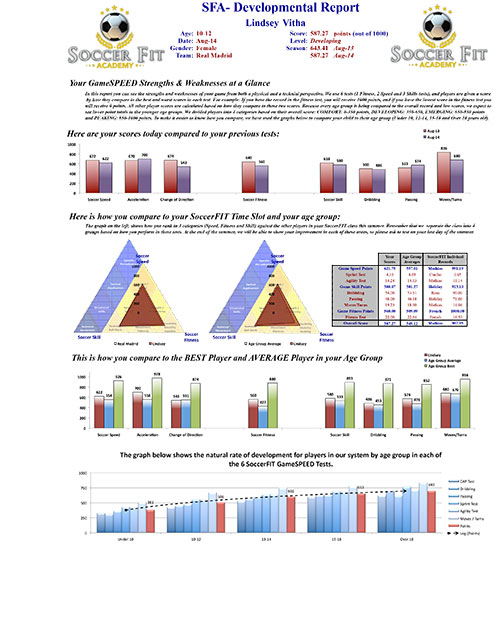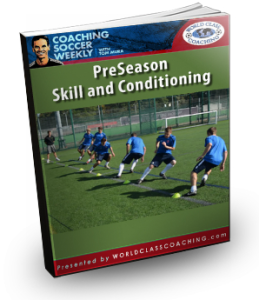Podcast: Play in new window | Download
Subscribe: Apple Podcasts | RSS
 The summer months are an important time because they give our players a chance to rest and recharge at the end of a long season before they prepare for the next one. You can’t constantly train at a high level without breaking down and risking injury and burnout. But it’s important for players, especially as they mature, to prepare for the challenges of returning to training.
The summer months are an important time because they give our players a chance to rest and recharge at the end of a long season before they prepare for the next one. You can’t constantly train at a high level without breaking down and risking injury and burnout. But it’s important for players, especially as they mature, to prepare for the challenges of returning to training.
Goals of Preseason Conditioning
- Get the players fit enough to start training
- Practice basic skills
- Injury prevention
It’s important for maturing players to have a base of fitness before they start to train. Small-sided games are a risky and inefficient way to create this base. Players are more susceptible to injury when they jump right into playing games without giving their body time adapt. Small-sided games often have too much stopping and starting to challenge the player’s cardiovascular system. You can get fit by playing but it’s going to take you longer than if you go in with a base to build from.
Start with Cardio
I begin by asking the players to run continuously for 24 minutes. I’ll have them do this two to three times a week until they are able to complete this comfortably.
Then we take the last three weeks before training begins to do runs where that are measured. These are best done on a track but can also be measured in other ways. I ask them to run twice a week with at least one day of rest between each run.
The first run is 24 minutes. The players record how far they were able to run in that time. The goal for each of the next four runs is to cover an increasingly greater distance. The second time they go for two 12-minute runs with a five minute rest.
The next week the players start with three eight-minute runs with a three minute rest between each one. The second run of the week is four six-minute runs with two minutes of rest between each one.
The final week the players complete six four-minute runs with only one minute between each run. The players will be shocked by how much more distance they can cover in 24 minutes of running than they could at the beginning of the program. You can have them complete another steady 24 minute run to finish the program.
This base of fitness will help your players get more out of the technical and tactical work you have planned for them.
Change of Direction Shuttles
I like to incorporate strength and fitness training along with ball work whenever possible. This is done once or twice per week but not on days when the players complete conditioning runs.
The players will be improving there touch along with turning and cutting ability while they are preparing their muscles to accelerate and decelerate quickly and smoothly.
How It’s Done
- Two cones 5-yard apart
- 20 Seconds On 40 Seconds Off
- 2-3 sets for each exercise
- Exercises (Each set is done for two weeks)
- Set 1 – 180 Degree COD Moves
- Repeat Step Over (R/L)
- Repeat Stop and Go (BOB)
- Repeat Cruyff
- Repeat Chop
- Repeat Hook
- Set 2 – 180 Degree COD Moves
- Shuffle In – Shuffle Out
- Repeat Step Over
- Shuffle In – Run Out
- Repeat Stop and Go
- Run In – Shuffle Out
- Repeat Cruyff
- Run In – Run Out
- Choice Move
- Set 1 – 180 Degree COD Moves
- Set 3 – 180 Degree COD Continuous Shuttle
- Up 10 yards and Back 5 yards
- Step Over (R/L)
- Stop and Go (R/L)
- Cruyff (R/L)
- Chop (R/L)
- Hook (R/L)
Testing
I begin each season by evaluating my players with a test developed by our conditioning experts at AthleteFIT. You can find a complete breakdown of the test with videos and descriptions by clicking this link to the AthleteFIT Game Speed Test.
There are six test: One Fitness Test, Three Skills Tests and Two Speed Tests.
For a complete description visit AthleteFIT Game Speed Test
The really powerful part of their program is that it gives you the ability to upload your results to their site for free. This gives each of your players a breakdown of how they scored in each of the three areas of Fitness, Skill and Speed. It also allows you to compare your scores against the other 30,000 players that have recorded their scores. You can see how you compare in your age group and with the best players ever tested.
 This is what the breakdown looks like. I’d encourage you to test some or all of your players and visit AthleteFIT Game Speed Test. Enter their scores and see what a powerful testing and development tool this can be.
This is what the breakdown looks like. I’d encourage you to test some or all of your players and visit AthleteFIT Game Speed Test. Enter their scores and see what a powerful testing and development tool this can be.
I think that it’s important that every coach offers their players some type of preseason conditioning program. You want your players come to your first training session fit and ready to train so you’ll be able to get them ready for their first games as soon as possible.
Printable Show Notes
The show notes for each episode are accessed through the WCC Training Center.
They are FREE but you will need at least a Free Membership to the Training Center in order to view and print them.
Click on the image of the notes and if you’re already logged in to the Training Center you’ll be taken to the Podcast page. If you’re not logged in your be taken to a login page where you’ll also be able to login or register if you are not already a Member.
Remember!
Make sure you subscribe to Coaching Soccer Weekly through iTunes, or your podcast provider of choice, to be sure you never miss an episode.
We would appreciate it if you would leave us a 5 star rating and/or a written review on iTunes to help spread the word about the show and ensure that we can continue to bring you top notch guests in the future.
In the Next Episode
I really enjoyed watching the Women’s World Cup over the last month. The US team progressed very well during the tournament and played their best games in the elimination rounds. Next week I want to talk about one of the keys to their success in my opinion and how I use this core principle with all of my teams.




Tom,
Thanks for putting this PODCast and show notes together. After more than four weeks off our team is just starting with summer practices in preparation for the first tournaments, ODP tryouts and the fall season. I was looking for a way to ensure that my son and his teammates can ramp up to full fitness in a fun and safe way. Your ideas have given me a lot of ideas to discuss with the head coach.
Thank you,
Doug
You’re Welcome Doug. Good luck in the new season.
I love your podcasts and listen every week. Great stuff that can be applied and manipulated for all age groups. Thank you for your generosity regarding the game we love.
Thanks Nick! I’m glad you’re finding it useful.
Was wondering how long your practices are when doing those initial 24 minute runs? If longer than 30 minutes, do you then let them work with a ball?
Those runs are not usually done as a team. The players do them on their own or in small groups. When I have done them as a team we just focus on the runs and we don’t do anything else.
Hi Tom,
Thank you again for the great information, and to echo Nick’s comments above, Thank you for your generosity.
Quick question, how many practices do you have before your first Fall season game? The reason I ask is because you mentioned that you give the players off from mid-June until the end of July. And if you start your conditioning program described above in the beginning of August and go for 5 weeks, that would take it to the first or second week of September. Is that when you start your soccer practices to get ready for the first game of the season?
Thank you again.
Thanks Torres, It’s my pleasure.
I should have made it clear that the preseason skill and conditioning work I give my players is done on their own during the summer break. That means they don’t do anything for two weeks or so and then start the preseason work. You might say that’s not much of a break but the skill and conditioning work only takes 25 to 30 minutes to complete and since their doing it on their own they can schedule it around their summer fun.
Let me know if you have any other questions.
I want to thank you for the podcasts. They are great! I was wondering though if you have goalies go through different fitness/skills tests? I always struggle with having them perform the same fitness requirements considering their position is completely different than field players.
Thanks Jon, I’m glad you are enjoying the podcast.
I don’t do any different testing for goalkeepers. It might be good to talk with the Sporting Goalkeeper Coach, John Pascarella, again and ask him about what he thinks a good fitness test for goalkeepers would look like.
Thanks for the idea!
Hi Tom,
Thanks for the podcasts, really wonderful.
My coaching is taking a turn!
Fred.
Hi Tom,
Love the podcast and can’t wait for my season to start so I can begin to implement everything.
I have a question about the Fitness testing portion. You do the 10 and back twice and then 25 and back in 30 seconds and then you say do it again. Is it done as soon at the player completes the first part so it would be 10 and back twice, 25 and back, 10 and back twice and 25 and back (you have 60 seconds to complete and 58 second etc.) Or do they have 30 seconds to complete the first one and if they finish early they wait and start again when the 30 seconds is up.
Thanks!
Thanks Patrick!
The players can wait until the time is up for one rep before starting the next but the ideal way to perform the test is to arrive at the start/finish line just as the time is up for one rep so they can begin the next. Arriving too soon means that they’ve used too much effort to complete the rep. They’ll burn themselves out faster that way.
Ok, so it is similar to the beep test in that aspect. Thanks a lot Tom! Keep up the good work!!
Hi Tom, I am looking for an example of the BOB COD. Do you have a video of this? Thanks
Dave,
I haven’t found a good video for that move either. The best I can do is this Footablility commercial. From 12 to 17 seconds in the move is being performed in the lower window.
https://youtu.be/L6dxue7lHfQ
Sorry, that’s the best I can come up with.